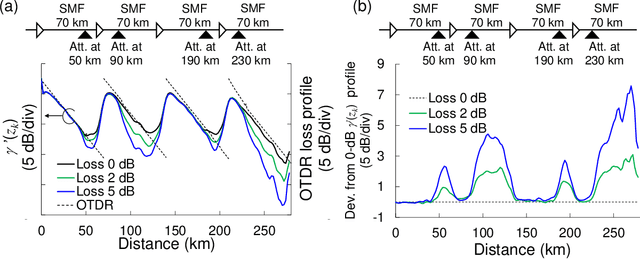Hideki Nishizawa
Dynamic optical path provisioning for alien access links: architecture, demonstration, and challenges
Sep 12, 2022



Abstract:With the spread of Data Center Interconnect (DCI) and local 5G, there is a growing need for dynamically established connections between customer locations through high-capacity optical links. However, link parameters such as signal power profile and amplifier gains are often unknown and have to be measured by experts, preventing dynamic path provisioning due to the time-consuming manual measurements. Although several techniques for estimating the unknown parameters of such alien access links have been proposed, no work has presented architecture and protocol that drive the estimation techniques to establish an optical path between the customer locations. Our study aims to automatically connect customer-owned transceivers via alien access links with optimal quality of transmission (QoT). We first propose an architecture and protocol for cooperative optical path design between a customer and carrier, utilizing a state-of-the-art technique for estimating link parameters. We then implement the proposed protocol in a software-defined network (SDN) controller and white-box transponders using an open API. The experiments demonstrate that the optical path is dynamically established via alien access links in 137 seconds from the transceiver's cold start. Lastly, we discuss the QoT accuracy obtained with this method and the remaining issues.
Physics-oriented learning of nonlinear Schrödinger equation: optical fiber loss and dispersion profile identification
Apr 13, 2021



Abstract:In optical fiber communication, system identification (SI) for the nonlinear Schr\"odinger equation (NLSE) has long been studied mainly for fiber nonlinearity compensation (NLC). One recent line of inquiry to combine a behavioral-model approach like digital backpropagation (DBP) and a data-driven approach like neural network (NN). These works are aimed for more NLC gain; however, by directing our attention to the learned parameters in such a SI process, system status information, i.e., optical fiber parameters, will possibly be extracted. Here, we show that the model-based optimization and interpretable nature of the learned parameters in NN-based DBP enable transmission line monitoring, fully extracting the actual in-line NLSE parameter distributions. Specifically, we demonstrate that longitudinal loss and dispersion profiles along a multi-span link can be obtained at once, directly from data-carrying signals without any dedicated analog devices such as optical time-domain reflectometry. We apply the method to a long-haul (~2,080 km) link and various link conditions are tested, including excess loss inserted, different fiber input power, and non-uniform level diagram. The measurement performance is also investigated in terms of measurement range, accuracy, and fiber launch power. These results provide a path toward simplified and automated network management as another application of DBP.
 Add to Chrome
Add to Chrome Add to Firefox
Add to Firefox Add to Edge
Add to Edge